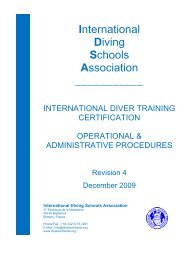Newsletter No. 20 - pdf ADOBE - IDSA The International Diving ...
Newsletter No. 20 - pdf ADOBE - IDSA The International Diving ...
Newsletter No. 20 - pdf ADOBE - IDSA The International Diving ...
Create successful ePaper yourself
Turn your PDF publications into a flip-book with our unique Google optimized e-Paper software.
Page 16<br />
RE-IMMERSION<br />
RECOMPRESSION? Bob Cole<br />
This is a pre-publication of Chapter 17 from Bob’s<br />
new book ‘Out of the Decompression Matrix’ which is<br />
due out later this year.<br />
Introduction<br />
A question that I’m often asked is: Why can’t<br />
we just put a diver with suspected DCI back in the<br />
water and recompression them? Well, I’ll tell you,<br />
but it may take some time.<br />
If you’ve just surfaced from a dive and say,<br />
you’ve missed a stop or two and you have DCI<br />
symptoms. What should you do? At first sight it<br />
would seem that re-immersion recompression<br />
would be the best and most logical option. After<br />
all it should be very quick, because there’s no<br />
time wasted calling the emergency services and<br />
Figure 1<br />
travelling to a hyperbaric chamber. It seems<br />
simple enough; the water can give you the same<br />
pressure as a hyperbaric chamber and you have<br />
breathing equipment etc on hand. So why not?<br />
When is said and done, the theory is that reducing<br />
the bubble size, by increasing the ambient<br />
pressure, relieves symptom and, at the same time,<br />
breathing pure oxygen allows better control over<br />
the elimination of the excess inert gas burden<br />
from body.<br />
However, the standard answer given by all diver<br />
<strong>The</strong><br />
author<br />
preparing<br />
to dive<br />
in Bikini<br />
Attoll<br />
training agencies is: Call the emergency services for<br />
advice, give the casualty pure oxygen to breathe, rehydrate<br />
them with still water, and don’t try to repair<br />
the situation by re-immersion recompression. Why?<br />
Usually, in the developed world, you are never<br />
too far from a hyperbaric chamber and competent<br />
medical help, but that may not be the case when<br />
abroad. <strong>The</strong>y then go on to say that the potential<br />
dangers of using the do-it-yourself (DIY) approach<br />
is too difficult to control, thus making it more risky<br />
than waiting for the emergency services and it is<br />
Figure 2<br />
less effective. Sounds a bit thin and lacks detailed<br />
information, doesn’t it? For this reason alone it bears<br />
some investigation, since Boyle’s Law works during<br />
the ascent, growing DCI bubbles that you don’t




